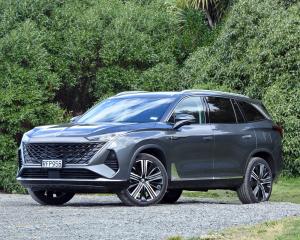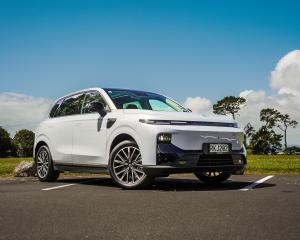
ROAD TEST
Commitment to modest-capacity, lion-hearted engines has been a Peugeot thing for a few years, but now it steps up.
Remember the previous generation of this car? On arrival in 2016, it presented in three distinct trim levels and with a choice of three engines, a 1.6-litre petrol, and a pair of diesels, in 1.6 and 2.0-litres, all connected to an eight-speed automatic.
All those have gone now. Today’s car has a mild-hybrid powertrain based on the 1.2 "PureTech" three-cylinder turbocharged petrol engine, connected to a six-speed twin-clutch gearbox. That’s it. It’s a new age.
The latest unit delivers less power and torque than previous offerings, but it almost matches the old diesels for economy and beats all the predecessor powertrains for low emissions.
This is a stepping stone towards Peugeot’s aim to be heavily electric by 2030; even now the 3008 and closely-related 5008 are produced in three strengths of electric-involved flavour. In either, above the "self-charging" type tested today, comes a plug-in hybrid. Beyond that sits a full electric.
In New Zealand we just see the "self-charging" starter, logically because PHEV and EV sales have slackened a lot in the past year, and also because battery implementation comes at a cost. As is, the hybrids cost more than the previous generation types. The new GT on test is the priciest 3008 yet sold here.

It’s certainly eye-catching and the detailing is amazing; but some will be uncertain. Don’t pass final judgement until you see how it illuminates in darkness.
The interior is also highly dressed, but with a twist. There’s no talking Peugeot out of its polarising i-Cockpit layout with a tiny steering wheel. Even though the wheel rim is now flattened at the top, anyone tall may find themselves craning to see the bottom part of the digital instrument display.
Nonetheless, the new ingredient of a vast curved 21-inch screen (technically two screens side-by-side) is a better solution than the small old instrument binnacle with a heads up display.
The instrument-dedicated end of the screen is easy to read, and can therefore be fathomed at a glance; the infotainment side is more heavily-loaded and the decision to keep buttons to a minimum means you’d be wise to bone up on the shortcut provisions.
The infotainment section is managed by Peugeot i-Connect, which features over-the-air map updates, Bluetooth, wireless smartphone connectivity and a multi-speaker stereo. It’s clever and touch interactions are fast and seamless, but the microprocessors can be overwhelmed if you rush it too much; fast-firing through the audio modes to finally settle on the radio put the test car’s system into a timeout frump, only resolved by turning the ignition completely off, then on again.
The source plant for the 3008, Sochaux in France, is the world’s oldest car factory still operating, having been commissioned in 1912, but it’s been utterly modernised. The 3008 is said to be the pride of the place; they’ve knocked out more than 1million, and the test example was an exemplar of assembly excellence. That it was the first of thousands of test cars I’ve had to lack a bonnet stay was a chuckle-raising quirk, but I’d say this was more likely due to some Kiwi meddling than any line worker oversight.

Eight-colour LED ambient lighting, a more bombastic stereo, heating for the steering wheel and front seats, a massage function for those chairs, and upholstery featuring tasteful Alcantara trim. The GT also stands out by having pixel-LED headlights with adaptive main beam and a unique tail light design, plus those Peugeot shield badges on the front wings.
Across-the-board driver assist, crash avoidance and safety provision run to six airbags, autonomous emergency braking, traffic sign recognition, lane assist and blind-spot monitoring, plus front and rear parking sensors. The GT includes adaptive cruise control with traffic jam assist, rear cross-traffic alert and 360-degree cameras to give a plan view of the car’s surroundings.
Safety evaluation by Euro NCAP and ANCAP has yet to occur. Peugeot will obviously be chasing a continuation of the maximum five-star rating achieved by previous iterations of the 3008.
The "French-ness" is patent. Using fabric coverings on the dash panels is a touch of flair that creates a stylish and tactile surface atop regular plastics. The bank of built-in ambient lighting also feeds a high-end impression.
Locating the drive selector high on the dash next to the air vents and beside the engine-start button is a quirk that takes some learning. Don’t feel shame if you try to select gears with the "iToggle" shortcut controller closer to your left knee. Everyone does it. It’s labelled as a "Drive mode", after all.
The wiper and indicator controls are reversed in European style, but it’s a shame that in respect to the split-level centre console, the lower part incorporating storage is also kept in left-hand-drive form, which adds awkwardness to accessing the large covered cubby with loads of storage space, plus USB-C ports.

The test car returned an average 6.3 litres per 100km overall from 512km operation. This was 1.1L/100km short of the count Peugeot claims under the WLTP test regime, but still seemed fair for a car of this size, given the mix of open road and urban driving. The on-board calculator reckoned, at the point of the car being handed back, there was enough left in the 55-litre tank for another 240km driving.
Meantime, brand confidence that it can do a reasonable job in performance terms is not overly-optimistic. Sure, it’s a car that entertains a measured pace. Yet though it sounds puny for a car of this size, by and large the powertrain delivers above expectation.
Naturally, moments of full performance require the engine’s neck to be thoroughly wrung, but at least it makes a nice noise when pushed hard. Settle back a bit and the powertrain’s refinement is very good.
Driving with a full load of occupants and a boot full of stuff will be the ultimate challenge, of course. That didn’t happen on test, but the relatively modest 750kg/1200kg braked towing maximum suggests you can expect only so much from an engine so small.
The Eco, Normal and Sport driving modes tweak the power steering assistance and throttle response and conceivably affect the hybrid side; for a long-duration city to city run, the car seemed perfectly happy in Normal; Sport stepped up the reactivity, but made it noisier.
Urban use gives the best opportunity for the battery and 15.6kW electric motor, which can only wholly propel the car at low speeds and for short bursts, but more generally does a good job of assisting the combustion engine to make it more efficient.

French brands like to make their cars fun, and there’s a certain dollop of joie de vivre to the 3008. Yet overall there’s nothing here that suggests it’s the keenest dynamic choice.
While the steering is quick and it doesn’t mind being hustled through corners, the suspension has been tuned as much for comfort as body control. In saying that, the ride quality is a touch on the firm side. Not to the point that it gets you rattled, but you can tell when smooth tarmac turns to coarse chip. It runs a large tyre for this class of car and that might contribute to it being so attuned to texture feel.
All in all, the 3008 has cleverly evolved a lot; this third generation is a big step from the last and bears very little commonality with the original.
What began as a chubby family car offering a mix of MPV and SUV promise has transformed into a sleek coupe-SUV with far more technology and a much grander marketing aspiration.
As a hybrid? It’s good, but not spectacular; there are other efficiency champions around, some for less spend.
AT A GLANCE
PEUGEOT 3008 HYBRID GT

Design and styling: ★★★★★
Interior: ★★★★
Performance: ★★★★
Ride and handling: ★★★★
Safety: ★★★★★
Environmental: ★★★★
SPECIFICATIONS

Engine: 1199cc three-cylinder petrol engine with 48 volt hybrid assist; 100kW/230Nm, six-speed dual clutch automatic; front-wheel-drive.
Safety rating: Untested.
Wheels and tyres: Alloy wheels, 225/55 R19 tyres.
Fuel and economy: 5.4l/100km, tank capacity 55 litres.
Emissions: 122g per km on combined cycle.
Dimensions: Length, 4542mm; width, 1895mm; height, 1641mm.
By Richard Bosselman












